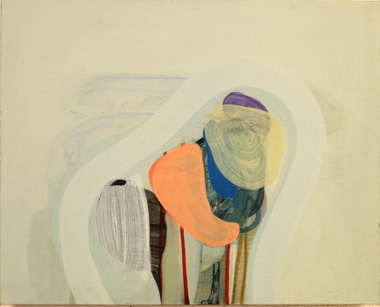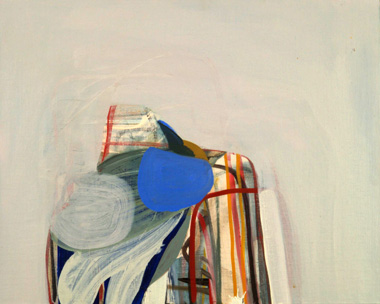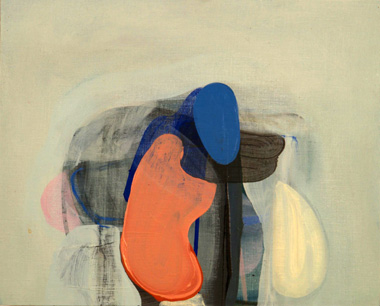 |
| Sinéad Aldridge: Pupa, oil on linen on MDF, 40 x 50cm, 2006; courtesy the artist |
Sinéad Aldridge calls the ten small canvases in this show “containers for intimate thinking.” Working on all of them simultaneously facilitated playful responses. This fact is easily observable in the placement of blue, a very Yves Klein blue at that.
In Sheltrun and in Tear jerker the blue shapes hover in front of the plane, blocking the view, whereas in Pupa the blue paint recedes behind the off-white veil like a detail. In Gl ü cklich, the blue becomes intoxicated with both possibilities: on the left it moves in front of the queue from behind a semitransparent veil, on the right it humbly dives into the depth of the image behind the white. The blue is the same, its position in space is not.
This behaviour of clearly defined hues appeared to me to be a random display, until I noticed the simultaneity in the positioning of the rare, hard-edged orange in Gl ü cklich. Being both in front of and behind the neighbouring colour, the orange detail reminded me of Gaston Bachelard (1884 -1962), namely in his rejection of the empirical world for its being random and pre-ordained. His proposition that all we know comes from the interaction between reason and experience, an interaction that includes imagination and reverie as cognitive forces, offers a fruitful perspective for these abstract images. By ‘abstract‘, I mean in this instance an emphasis on the salient qualities of painting as mute poetry and companion for contemplation. I am not thinking of a complete withdrawal of resemblance and of illusions. On the contrary, I perceived realities that exist only in my perceptions: a closed eye, a sad female face, etc. That a distortion of a direct sensory perception is invited is not a weakness; rather, it is a robust acknowledgement that our senses, especially the eye, can be deceived. Aldridge emphasises the playful and complex character of these images in the choice of their titles: Dura mater and Gl ü cklich refer to her experiences of Latin and German cultures.
 |
| Sinéad Aldridge: Scheltrun, oil on linen on MDF, 40 x 50cm, 2006; courtesy the artist |
The display in the Dock embodied a childlike joy of lightness when images were placed under or above the eye level.
The images are all painted in front of a ground, bar one: Sheltrun. This image is clearly behind the ground, trying to get through the tight opening as if through caesarean section. The association with birth is not isolated – in several cases the dominant shape looks like a uterus, eg Pupa, Dura mater, and What remains to be asked .
The other ever-present motive is that of parallel vertical lines, energetically yet calmly positioned as if in support of a bulk of organic matter. They are at times opaque, or translucent, often in strong primary colours. I think of them as details of the fragments, where the fragment is the figure on the ground. I make a distinction between the fragment and the detail, which is an isolated fact that can be considered on its own, eg an eye. A fragment on the other hand is like a dependent clause in a language; it is incomplete and detached from some large individual essence. Nevertheless, fragments offer the interaction proposed by Bachelard and mentioned earlier. All ten paintings focus all the dynamic elements in the figure, the ground being painted with one or two tones, sometimes opaquely solid, at times smoky and airy.
The relationship of a figure to the ground in the paintings facilitates the vitality of the fragment to forge an illusion that we can comprehend the whole from incomplete elements. Things are affected by where they are and what surrounds them; in the case of these paintings it is the unreal atmosphere in which they are – no source of light, no definition of space, no time or season. The images become still lifes, landscapes, heads or insides of bodies with an extraordinary ease. They camouflage their own identity – if they ever had one – by slipping from one state to another and another. Yet, physically they are utterly and completely stable. Moreover, they are enclosed.
 |
| Sinéad Aldridge: Tear jerker , oil on linen on MDF, 40 x 50cm, 2006; courtesy the artist |
The paradox between changing identity and closure is controlled by the feature which I call here the paradox of the ‘envelope‘. While the slippages mentioned above advance the principle of continuity, the curves that envelope the figures act as pathways for looking. The closure makes it probable that I look at a whole. That probability, however, cannot guarantee that that which is enclosed does or does not yield information. ‘Information‘? The word sneaked in as a sign of my insecurity as to what am I looking at. It is inappropriate, as it is wrong to arrive bearing a priori expectations. There is another way. An envelope calls for scaling down, for the rounding off of multitudes to smaller, manageable quantities. An envelope is not about information, it is about approximation, about guessing what it is and how can I know what is inside it. An envelope encourages multiple questioning of meagre information. Enrico Fermi (1901 -1954) comes to mind, a Nobel prizewinner (1938) who championed questioning skills. In a Fermi question, the goal is to make a reasonable assumption about the issue at hand, not to obtain an exact answer. The beauty of the Fermi question is that it requires many more questions. It demands communication, it utilizes estimation and it emphasises process. So do the paintings in this Penumbra exhibition.
Aldridge paints a dream world, a corner of a universe, unsettling in its harmony, with the irrationality of depth and rewarding in its playful creativity. A paradox of happiness – I single out Gl ü cklich as the one imbued with freedom. Freedom not quite blocked; still in a shadow. Penumbra is an area in which something exists to an uncertain degree.
Slavka Sverakova is a freelance writer on visual art.